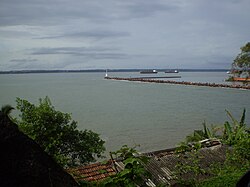Vasco da Gama, Goa
|
Vasco da Gama वास्को द गामा |
|
|---|---|
| City | |

Vasco Harbour
|
|
| Location of Vasco da Gama in Goa | |
| Coordinates: 15°23′53″N 73°48′40″E / 15.39806°N 73.81111°ECoordinates: 15°23′53″N 73°48′40″E / 15.39806°N 73.81111°E | |
| Country (1961-present) |
|
| State | Goa |
| District | South Goa |
| Sub-district | Mormugao |
| Elevation | 43 m (141 ft) |
| Time zone | IST (UTC+5:30) |
| PIN | 403802 |
| Area code(s) | 91-832 |
| Vehicle registration | GA-06 |
| Website | www |
Vasco da Gama /ˌvæskoʊ də ˈɡæmə/, often shortened to Vasco, is the largest city in the state of Goa on the west coast of India. It is named after the Portuguese explorer Vasco da Gama. It is also the headquarters of the Mormugão taluka. The city lies on the western tip of the Mormugao peninsula, at the mouth of the Zuari River, about 30 kilometres (19 mi) from Panaji, Goa's capital, and about 5 kilometres (3.1 mi) from Dabolim Airport.
The city was founded in 1543 and remained in Portuguese hands until 1961, when Goa ceased to be a Portuguese territory. The 1888 constructed Mormugao port remains a busy shipping route in Asia. Even today it is one of the major ports of independent India and around one-third of India's ore exports are said to leave from here. The ship-building area of Goa Shipyard Limited that builds Navy and Coast Guard vessels was also built here in 1957 (during the Portuguese-era). Initially built around the city's harbor as the barge-repair yard Estaleiros Navais de Goa, the area has now expanded to include more related activities. The Indian Navy also has a conspicuous presence in Mormugao, with its vast campus, and its contested control over the Dabolim Airport enclave.
...
Wikipedia


